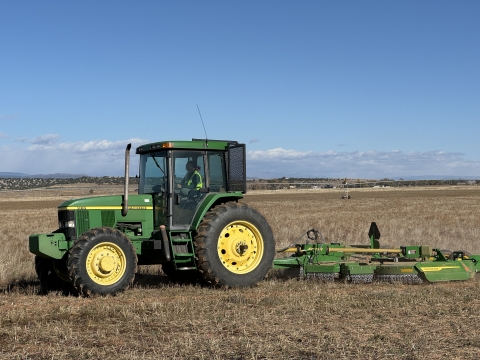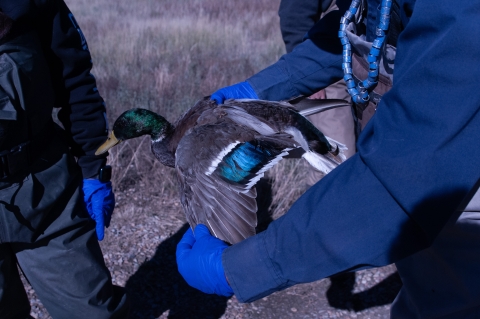What We Do
The National Wildlife Refuge System is a series of lands and waters owned and managed by the U.S. Fish and Wildlife Service. Wildlife conservation is at the heart of the refuge system. It drives everything we do from the purpose a refuge is established, to the recreational activities offered there, to the resource management tools we use. Selecting the right tools helps us ensure the survival of local plants and animals and helps fulfill the purpose of the refuge.
When you visit the refuge, you will notice many impoundments. These impoundments occur where playa lakes (shallow depression wetlands, generally smaller than 30 acres) have occurred naturally and are currently managed to provide ponds and lakes of various sizes and depths. The refuge lowers and raises water levels in the ponds to provide the best mix of feeding, nesting, and breeding habitats for waterfowl and other water birds. This mix of habitats benefits wading, diving and dabbling birds.
Refuge staff, in coordination with the local water user's association, spends a great deal of time making sure the water conveyance system functions as smoothly and efficiently as possible. In order to conserve water in this semiarid zone, open ditches have been replaced with more than 13 miles of gravity-fed pipeline. This has also provided a more efficient means of irrigating up to 700 acres of farm fields, where crops such as oats, barley, wheat, and peas are planted to provide food for a variety of migratory birds, like ducks, geese and cranes.
On Las Vegas National Wildlife Refuge, you will see wheat, barley, and peas planted for wildlife to eat and build their fat reserves to fuel their lengthy migration. National Wildlife Refuges are often islands in an ocean of fragmented habitats, especially for birds that migrate thousands of miles north and south. To preserve habitats and to provide for a wide variety of wildlife management makes decisions to best ensure wildlife and migratory waterfowl have what they need to rest, recuperate, and feed before they move on from the refuge.
Management and Conservation
Providing optimal habitat for wildlife on the refuge is a management priority. Refuge management practices such as browse/grain crop production, prescribed burning, invasive species invasive species
An invasive species is any plant or animal that has spread or been introduced into a new area where they are, or could, cause harm to the environment, economy, or human, animal, or plant health. Their unwelcome presence can destroy ecosystems and cost millions of dollars.
Learn more about invasive species control, and water manipulation enhance species diversity by ensuring a variety of habitat types.
Farming
Using the farming pivots on the refuge management and our biologist makes decisions on how best to provide feed/browse for our migratory waterfowl. This is an important conservation tool for staff to allow waterfowl to utilize different parts of the refuge as a resting place, where they might not have food sources along their migratory routes. Different farming practices and crops are used over time to increase seed germination, allowing for a more hands-off approach for staff.
Playa Lake Management
Playa lakes are depressions in our landscape traditionally fueled by precipitation from the mid-summer monsoons. Over time, some playa lakes on the refuge, during homesteading, were converted to water-holding sites, allowing farmers and now refuge management to store water on the refuge lands to move through the landscape when needed. This is an important tool for managers to allow refuge staff to allow natural dry cycles to some of our playa lakes, while also providing sanctuaries for nesting and migrating birds.
Our Projects and Research
National Wildlife Refuges are a place for wildlife and a place for everyone to learn and discover more about wildlife and the outdoors. We offer the ability to use our refuge as a place of research for grad students, college labs, and more from local colleges, universities, and state and federal organizations. If interested in performing research or utilizing the refuge for a project, please contact: alyssa_lu@fws.gov.




